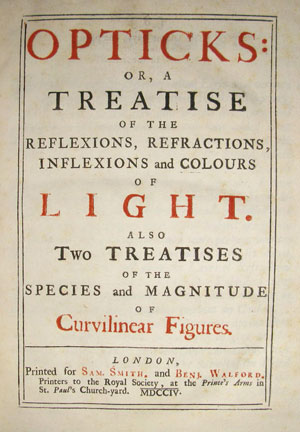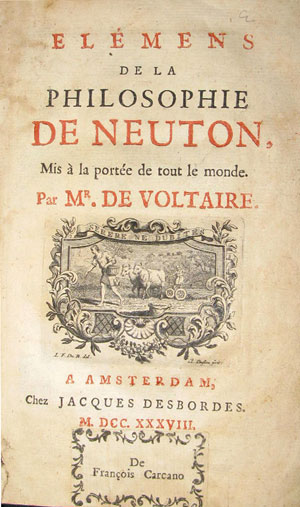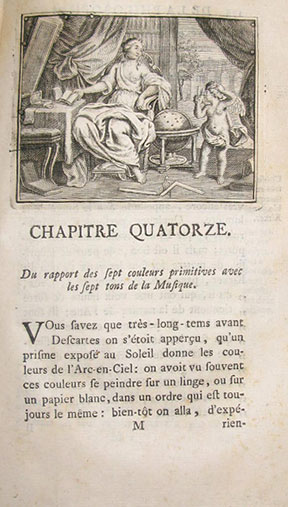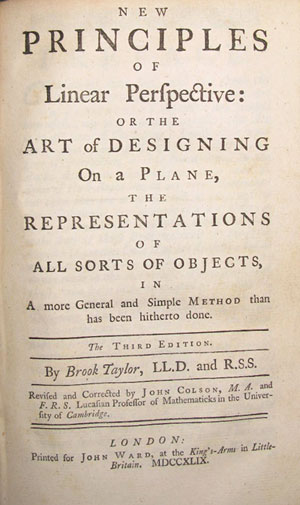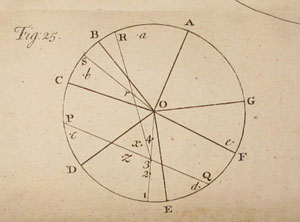Isaac Newton (1642–1727)
Isaac Newton, Opticks: or, A Treatise of the Reflexions, Refractions, Inflexions and Colours of Light (London, 1704)
Newton discussed music in a number of different contexts. Although not a lover of practical music he was interested in music's underlying principles and the notion of cosmic harmony. A manuscript notebook written early in his career (now in Cambridge University Library, Add. MS 4000) reveals his interest in the mathematical division of the scale whilst in his Principia mathematica Newton described sound's propagation through air to establish a new dimension in the mathematical study of music in the field of acoustics. 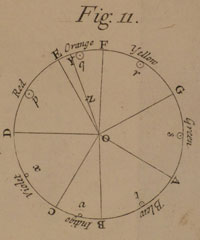
Of particular interest were correlations he perceived between the colour spectrum and the musical scale. In his popular work Opticks (and elsewhere) Newton suggested that his spectrum of seven colours was governed by the same ratios underlying music's diatonic scale. Although subsequently discredited, throughout the 18th century this theory was seized upon by musicians and scientists seeking evidence of universal laws common to music and nature.
Voltaire, Elémens de la philosophie de Neuton (Amsterdam, 1738)
The French Enlightenment writer and philosopher Voltaire helped make Newton's optical and gravitational theories accessible to a wider public and encouraged their general acceptance.
In his Elémens de la philosophie de Neuton Voltaire was one of many theorists eager to adopt and promote Newton's theory concerning colour and the diatonic scale. 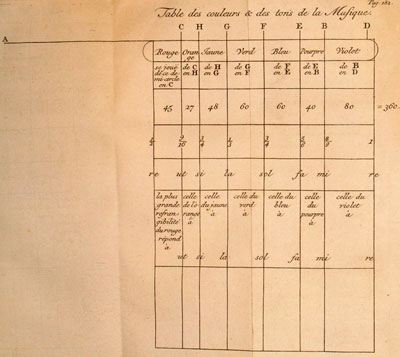
Brook Taylor, New principles of linear perspective: or, The art of designing on a plane the representations of all sorts of objects, in a more general and simple method than has been done (London, 1749)
As well as being a prominent mathematician and Royal Society fellow, Brook Taylor (1685–1731) was an accomplished musician and member of the Academy of Ancient Music. Established 1726 in London as an organisation devoted to the study of earlier music, many of the Academy's members were also heavily engaged in an agenda to establish music's theoretical basis in universal principle.
Taylor's Methodus Incrementorum Directa et Inversa (1715) had been seminal in reducing to mechanical principles the form of movement of a vibrating string. In his Linear Perspective (1715) Taylor had sought to set out the principles of visual art and thus established for himself a prominent place in the history of perspective. A staunch supporter of Newton, Taylor built on Newton's ideas concerning the supposed correlations between colour and the musical scale in his New Principles of Linear Perspective (1719).
In an appendix entitled 'New theory of mixing colours' Taylor included an expanded version of the colour diagram Newton had presented in his Opticks (as described above). In Taylor's version the circle is divided into seven colour segments, each one lettered according to a note name (A–G) and arranged to correlate to the mathematical 'proportions of the musical notes'. In a manner invoking musical dissonance and consonance, Taylor sought through this diagram to explain how the mixing of 'perfect' colours creates other 'less perfect' colours.
Bibliography
- Barker, Andrew, ed., Greek Musical Writings, 2 vols. (Cambridge, 1984–9)
- Chenette, Louis Fred, 'Music Theory in the British Isles during the Enlightenment', PhD diss., Ohio State University, 1967
- Christensen, Thomas, Rameau and Musical Thought in the Enlightenment (Cambridge, 1993)
- Clark, Suzannah and Alexander Rehding, eds., Music Theory and Natural Order from the Renaissance to the Early Twentieth Century (Cambridge, 2001)
- Gouk, Penelope, Music, Science and Natural Magic in Seventeenth-Century England (New Haven, 1999)
- Kassler, Jamie C., The Science of Music in Britain, 1714–1830: a Catalogue of Writings, Lectures and Inventions, 2 vols. (New York, 1979)
- __ Music, Science, Philosophy: Models in the Universe of Thought (Aldershot, 2001)
- __ The Beginnings of the Modern Philosophy of Music in England: Francis North's A Philosophical Essay of Musick (1677) with Comments of Isaac Newton, Roger North and in the Philosophical Transactions (Aldershot, 2004)
- Miller, Leta E., and Albert Cohen, Music in the Royal Society of London, 1660–1806 (Detroit, 1987)
- Wardaugh, Benjamin, Music, Experiment and Mathematics in England, 1653–1705 (Ashgate, 2008)

